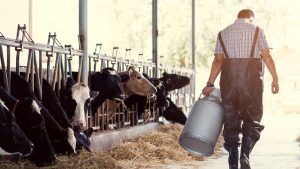
The overconsumption of meat is having detrimental repercussions for human and planetary health. We discuss what these are, and what we can do about it, with Stockholm Environment Institute scientist Cleo Verkuijl.
The way in which meat is produced, and the amount that is consumed have important implications for human and planetary health. While political leaders are slowly starting to acknowledge the ramifications of industrial meat farming, the many concerns and hurdles along the supply chain need to be addressed holistically. Addressing current government support for industrial livestock farming, protecting workers during the potential transition away from industrial livestock farming, and safeguarding animal welfare standards when purchasing behaviours may fluctuate are just some of the elements that need to be considered, and with all the necessary stakeholders involved.
To discuss the impact of meat overconsumption and the complexity of transitioning to more sustainable farming practices and diets, Lorna Rothery spoke to scientist at the Stockholm Environment Institute, Cleo Verkuijl.
How has the scale of meat production and consumption changed in recent years? What are the projections for the future?
Global meat production has increased fivefold since the 1960s and is projected to increase more than 60% between 2010 and 2050, largely a result of rising income levels and a growing population. These trends are alarming; it will be difficult to meet many of the world’s sustainability targets if meat production and consumption continue in this way.
Under these global trends lies a lot of local nuance. Meat consumption is highly unevenly distributed globally. Researchers have therefore suggested that high-income countries should take the lead in transitioning away from animal protein, with meat consumption in the Global North needing to decrease an estimated 70-80% to be sustainable. Several middle-income countries such as Argentina and Brazil should soon follow, as they also have unsustainably high levels of per capita meat consumption. By contrast, some groups in lower-income settings may need to increase their animal product consumption to meet their nutritional needs, at least in the short term.
In richer countries especially, a growing number of people are identifying as flexitarian, as well as vegetarian or vegan. Paradoxically, however, this is not always translating strongly into clear reductions in meat consumption in these countries: it seems more and more people are seeing the importance and value of shifting their diets, but not yet translating this into strong action. This opens up a potentially valuable role for policymaking, to help ensure that it becomes easier for consumers to choose healthier and more sustainable options.

If there is planning in place for retraining, reskilling and investment in a region, there is a future for people. You cannot make a policy in isolation, it needs to be designed with all the environmental, health, social and animal dimensions in mind
Can you outline how meat production and consumption impact human and planetary health?
Tackling the impacts of industrial animal agriculture needs to be a priority for anyone concerned with planetary or human health – which are of course themselves interlinked.
Recent estimates suggest at least 16.5% of global greenhouse gas emissions may come from livestock systems, including both meat and dairy. The industry is a huge driver of biodiversity loss, since large tracts of land are used for cattle grazing, or to grow feed for farm animals. Industrial livestock production is also associated with air and water pollution which disproportionally affect vulnerable groups and ethnic minorities who tend to be situated near large livestock facilities.
Animal product production and consumption impact human health through three key pathways. First, 80 billion land animals are raised and killed each year for meat alone. The rearing of many animals together, as well as the destruction of habitat linked to clearing land for animal feed, increases the risk of infectious disease emergence. Second, the consumption of red and processed meat has been linked to non-communicable diseases like diabetes, heart disease, and certain types of cancer, especially colorectal cancer. Third, the overuse of antibiotics in the livestock sector – about 70% of total antibiotic use – is another pressing problem, as it increases the risk of antimicrobial resistance. Antimicrobial resistance is already killing more people than diseases such as HIV/AIDS or malaria do, and this number is expected to increase.
Unfortunately, many governments are still hesitant to give these issues the attention they deserve. The most recent UN climate and biodiversity conferences failed to recognise the need to shift away from high levels of meat consumption, or even mention the issue explicitly in their main outcome documents. And most national dietary guidelines are still not aligned with global environmental and health targets.
Despite scientific evidence about the negative links between the overconsumption of animal-based products and human and planetary health, many people continue to eat meat-rich diets, why is this?
This is down to a combination of factors. Taste, habit, and price all affect what we eat. In many places, meat also has strong cultural and social connotations. Moreover, the potential adverse health impacts of high levels of meat consumption are still not necessarily widely appreciated.
While our individual, family, and community-level choices do make a big difference, we also need to take a hard look at the policy environment that upholds our unsustainable food system. Government policy – or the lack thereof – steers our dietary options and our choices in many ways, and there are enormous economic interests involved in preserving the status quo.
Take the price of meat. In many cases, this price is artificially low, since the health and environmental impacts are not reflected in the price. Workers in the industry, as well as the animals themselves, are often treated very poorly. Governments also subsidise industrial animal agriculture with billions of dollars each year. Recently, certain livestock and farmers’ lobbies have been engaged in efforts to weaken climate legislation and push a ban on the use of terms such as ‘sausage’, ‘burger’ and ‘milk’ for plant-based alternatives. And even regions like the EU, which talks a strong talk on sustainability, support advertising campaigns for meat products with tens of millions of euros each year.
What groups and resources should be mobilised to help scale down meat production and consumption?
It will be important to continue to build cross-cutting coalitions of communities working towards a healthier food future, including people working across healthcare, the environment, employment, and animal welfare. Working in coalitions can help us speak with a stronger voice, and it can also help us pursue holistic approaches with multiple co-benefits across these issue areas.
One area that my research highlights is the need for any food system transition to be ‘just’. This just transition approach emphasises that large socio-economic shifts should be planned and implemented in a way that is socially fair, and the concept has become an important pillar of climate change policy. The approach is most commonly applied in the energy sector, but we now also need to engage in inclusive just transition planning and support in the food sector. It entails giving a voice and support to affected stakeholders, including farmers and other workers, communities, and consumers as we move towards a more sustainable food future.
Can you highlight any countries that have made positive steps to reduce the production and consumption of meat?
Perhaps one of the most significant examples is that of the Netherlands, which has announced plans to cut livestock numbers by 30% by 2030 to tackle pollution from ammonia and nitrous oxide. The Dutch government have put aside €25bn to support livestock farmers, either by buying them out or by helping them transition to other forms of agriculture.
Other relevant policy developments include an announcement by Ireland that it will cut agricultural emissions by 2030, with implications for the meat and dairy industry, and a New Zealand proposal to begin taxing emissions from animal agriculture, which would be a world first.
It is important to note, however, that these policy shifts have been met with considerable opposition from farming communities, pointing again to the need for inclusive and timely processes to plan such transitions. As governments pursue these policies, it will be important to consider their impacts holistically, including environmental, health, social and animal welfare implications.
Several governments are also betting on the rise of alternatives to conventional animal products, with countries such as Canada, Denmark, Singapore, and the UK beginning to invest in R&D in this sector. While it will be useful to understand the health and environmental benefits of some of these substitute products more fully, overall, they show promise in making the switch towards more sustainable diets more palatable for many consumers.
Cleo Verkuijl
Scientist
Stockholm Environment Institute
https://www.sei.org/
https://www.linkedin.com/company/stockholm-environment-institute
https://www.facebook.com/StockholmEnvironmentInstitute
https://twitter.com/SEIresearch
This article is from issue 24 of Health Europa Quarterly. Click here to get your free subscription today.

























